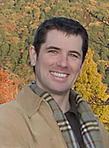Jeffrey E.F. Friedl's Blog, page 30
April 29, 2015
Coffee at Cowbell: Short but Intense Bike Ride in Northern Kyoto
I had a wonderful little bike ride today, 48km distance with 1,720m of
elevation gain (30 miles of distance with 5,600 feet of elevation gain).
(The report of the
ride at Strava reports longer distance and less elevation gain, but I
trust Google's elevation data for Kyoto more than I truest my phone's
GPS/GLONASS unit's elevation.)
Things didn't start well.
I went downstairs to my bike to find the rear tire quite flat, likely a
slow leak from the
spoke problem I had on the ride last week. I'd ridden 70km after it was
fixed so I thought it was fine, but apparently not.
I could have changed the tube myself, but I worried that the problem
originated in the wheel and so a new tube would quickly go flat as well, so
I pushed the bike to my cycle shop
and had them check it out.
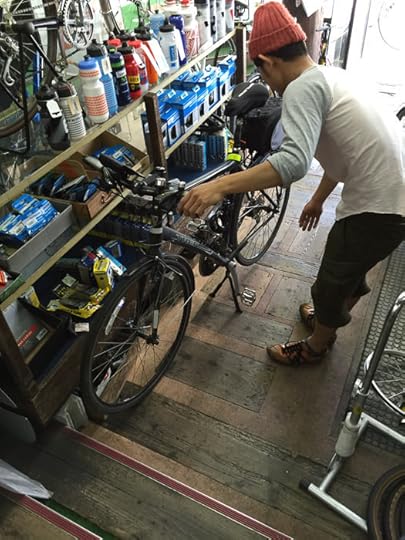
iPhone 6 Plus + iPhone 6 Plus back camera 4.15mm f/2.2 at an effective 29mm — 1/15 sec, f/2.2, ISO 50 —
map & image data — nearby photos
Fixing a Flat
A short wait and $15 later I had a new tube and
a diagnosis that my wheel was fine. At noon I set off for the mountains.
40 minutes and 14km later I arrived at Kurama Temple (鞍馬寺), and took a short break
to buy a bottle of sports drink...
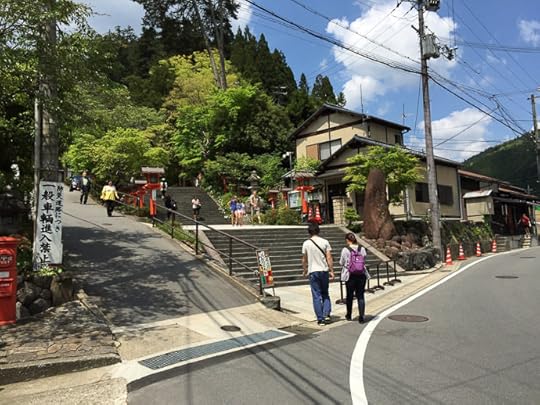
iPhone 6 Plus + iPhone 6 Plus back camera 4.15mm f/2.2 at an effective 29mm — 1/2200 sec, f/2.2, ISO 32 —
map & image data
— nearby photos
Entrance to the Kurama Shrine
marks the “real” part of the climb
This is where we had paused last week for cyclist photo ops.
Anyway, I quickly took off for Hanase Pass (花背峠).
I would be my third attempt, the first having
been 2½ months ago on my first real ride, and
the second a week ago.
I'd climbed 200m in the 14km it took to get here, but now would almost quadruple that
in less than half the distance... from here it's 6.2km of unrelenting slope.
This time I had one single secondary goal: make it to the top without
pausing. (My primary goal, as always, is make it to the top without
giving up).
So, I let myself fall into the easiest gear right away, and I just
stayed there for the 38 minutes it
took to the top. This time was 9:04 faster than the first, with its slushy roads
and heavy camera. It was 4:22 faster than last week, which lacked the snow
but not the
camera.
Oddly, my heart rate never got above 138 bpm. Mostly my body could
handle the climb just fine... the bigger problem is that I'm really
weak-willed when it comes to physical exertion for its own sake. That's why
my primary goal is always “don't give up”.
Anyway, I was pleased to arrive at the top without having stopped for
anything, and like I said, my body can handle the slow pace, so I just kept on
going down the other side. This was my first time to go down without the
road being a sheet of ice, and it was exceedingly pleasant.
Five minutes of lovely downhill sweeping curves later, I was at “Cowbell”, a
restaurant in the middle of nowhere:
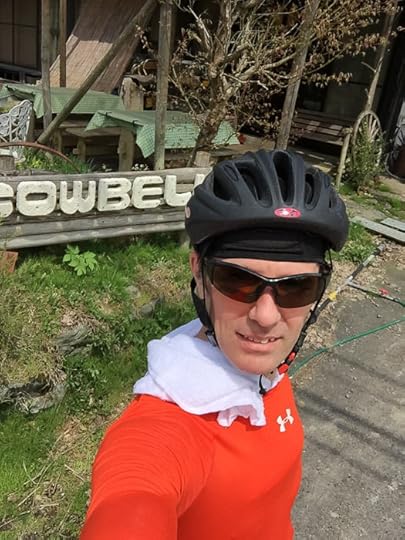
iPhone 6 Plus + iPhone 6 Plus front camera 2.65mm f/2.2 at an effective 31mm — 1/1200 sec, f/2.2, ISO 32 —
map & image data — nearby photos
Selfie at Cowbell
喫茶カウベル
I ordered a cup of coffee and sat outside. I hadn't had anything to eat
yet today, and I wasn't hungry, but I thought I should have some energy for the return climb.
I didn't want either of the two food items they had on the
menu (toast and curry rice), so I asked whether they'd make an onigiri
(rice ball) for me, and they kindly did:
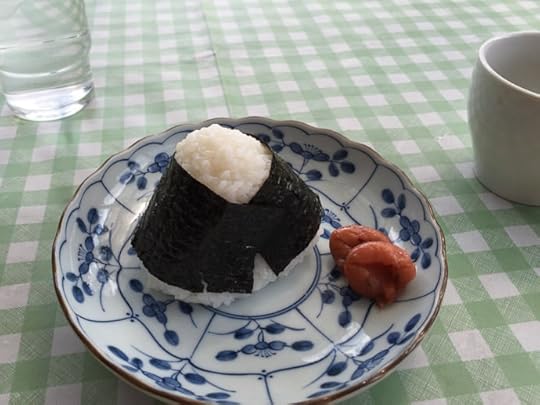
iPhone 6 Plus + iPhone 6 Plus back camera 4.15mm f/2.2 at an effective 29mm — 1/500 sec, f/2.2, ISO 32 —
map & image data — nearby photos
Rice Ball
with umeboshi
I didn't want cramps on the way back, so sat and read a book for 50 minutes, then headed back.
It was my first time to ride up the back side of the mountain, and it
ended up giving me the best feeling of accomplishment. I was in a middle
gear just flying up, waiting for the difficult/steep sections that would
require dropping down to the easiest gear, at which point I'd settle into a “just get it done”
pace.
And suddenly I was at the top. I was shocked.
I knew this section was nowhere near as tough as the first climb (it
turns out that it's just 170m of elevation gain over the course of 2.7km),
but the hard parts never came, and it took just 13:10 (flying downhill on
the way in had taken five minutes). Felt great!
Then from the pass back down to Kyoto, standing on the petals, flying
down and around corners at an average speed of 36kph, waving “hi” to
cyclists riding up. Felt great.
Tomorrow should be a much longer ride...
April 26, 2015
Potential Privacy Issue with Lightroom CC/6 and People Keywords
Lightroom CC/6 has been
out for a few days, and in working with Lightroom's new Face Tagging
feature, I've run across something that could be a privacy issue for some
folks.
Keywords in Lightroom have an “Include on Export” option; if it's
disabled, the keyword is not (supposed to be) included in exported copies
of photos. This is useful for workflow-related keywords that you use merely
to help manage your catalog, or for keywords you'd rather not expose to the
public.
The problem I've discovered in Lightroom CC/6 is that the “Include on Export”
option is ignored if it's a “Person” keyword (one used with the new Face Tagging feature).
For example, imagine tagging photos from an office party and giving your boss
the snarky name “My Jerk of a Boss”. Of course, you'd not want to expose that
in copies you uploaded or shared with others, so you'd think you were safe
by disabling “Include on Export” like this:

Lightroom's Publish/Export dialog includes a standard section on what metadata to include in
the exported copies:

The “Remove Person Info” option is new in Lightroom CC/6, and it seems
that it (and it alone) controls whether “Person” keywords are
included in export. If this remove option is not
turned on, all Person keywords are exported even if their “Include on Export”
option has been explicitly disabled.
In the “My Jerk of a
Boss” example, you might have wanted
other People keywords to be included, so not turned on the “Remove Person Info”
option, thinking that the lack of “Include on
Export” would keep “My Jerk of a Boss” out of the images you share. I
assume that's how it's supposed to work, but it doesn't.
I don't suppose that this bug (if that's what it is) will actually affect very many people,
but if it does, it could be a doozy.
I've reported it to Adobe. I'll update this post with new info as it becomes available.
In related news, I've figured out how to bring the Face-Tagging feature
to my Facebook
plugin. For example, after having used Lightroom's Face Tagging feature to identify faces of
friends in the photos from the 100km bike ride I
recently wrote about, all the tagging in
the exported copies at Facebook was automatic via the beta version of
my plugin. It was nice not to have to walk through every copy at Facebook
and tag people.
So that's something to look forward to. It was while working on this that I discovered the potential privacy issue.
April 25, 2015
Pleasant 105km Bike Ride From Kyoto, Along Lake Biwa, to Takashima’s Shirohige Shrine
Nikon D4 + Sigma 35mm F1.4 DG HSM — 1/8000 sec, f/1.4, ISO 100 —
map & image data — nearby photos
Manseki Kanemitu in a Bed of Flowers
at Lake Biwa, Shiga Japan
花壇の中の万石さん、琵琶湖(滋賀県)
I finally made my first 100+km bike ride the other day, cycling with some folks from
the Cycling Kyoto Facebook group.
Strava says the
ride was 105km (65 miles). Even though it's 10% longer than the first long ride I
did, this time was much easier because it had only 1,300m (4,200
ft) of vertical rise, only about a ⅓rd of the first ride's climbs. Even last month's 58km ride
was much harder, again, due to having more elevation. Flat distance seems
to be easy.
Anyway, as usual we met in front of the Sanjo St. Starbucks...
Nikon D4 + Sigma 35mm F1.4 DG HSM — 1/1000 sec, f/8, ISO 400 —
map & image data — nearby photos
Getting Ready to Take Off
8:10am
出発点 :三条大橋のスタバ (京都市内)
Ross,
Gorm, and
Manseki
Nikon D4 + Sigma 35mm F1.4 DG HSM — 1/2500 sec, f/2.8, ISO 100 —
map & image data — nearby photos
Ride Preparation
at least if you're a rider like me
撮影の準備
Nikon D4 + Sigma 35mm F1.4 DG HSM — 1/1000 sec, f/8, ISO 320 —
map & image data — nearby photos
Getting Out of the City
always feels nice
やっと田舎
8:38am - taken while cycling at 25 km/h
Nikon D4 + Sigma 35mm F1.4 DG HSM — 1/1000 sec, f/6.3, ISO 320 —
map & image data — nearby photos
First Climb
( we'd picked up one more rider, Kumiko Naka, along the way )
8:42am - taken one-handed while cycling at 27 km/h
DMC-SZ9 at an effective 26mm — 1/800 sec, f/3.1, ISO 100 —
image data
I'm in Purple This Time
less lively than my yellow/green getup a week ago
今日は僕はなすびくんです。
(photo by Manseki Kanemitsu)
Nikon D4 + Sigma 35mm F1.4 DG HSM — 1/1000 sec, f/5, ISO 280 —
map & image data — nearby photos
Lovely Countryside
10:05am - taken while cycling at 28 km/h
気持ち良い部分
The route I'd planned brought us through some of the more mild mountains
of northern Kyoto early on, and within 26km (a quarter of the planned
distance) we were done with almost all the climbs. It was that point that
Ross turned around to forge his own more-mountainous path. For the rest of
us, the last 80 kilometers would be downhill or flat, except for one short
but intense hill near the end.
Nikon D4 + Sigma 35mm F1.4 DG HSM — 1/400 sec, f/5, ISO 6400 —
map & image data — nearby photos
Spoke Broke
getting unbroke
スポックの修理、at サイクルショップ にしもと in Wani City, Shiga
At some point coming down the mountain toward Lake Biwa (the largest lake in Japan), a
spoke on my rear wheel broke. (Putting it another way, my rear wheel misspoke 
April 23, 2015
Matt Campagna Wigglegrams Kyoto
Note: this article may not appear properly in news readers.
This article contains interactive aspects that are likely removed by most news readers. Please see this particular article directly on Jeffrey's blog for full functionality.
div#dNitZFnrpnrpTcA img { width:690px; height:442px; visibility:hidden; position:absolute; top:0; left:0; border: solid 10px #311}
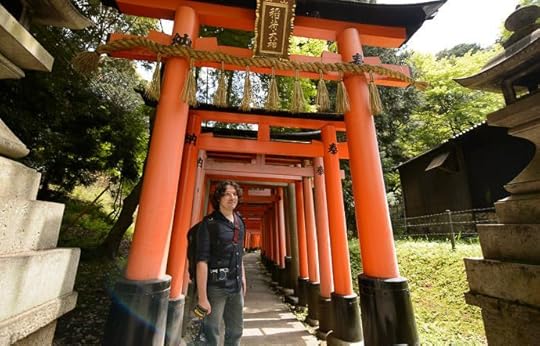
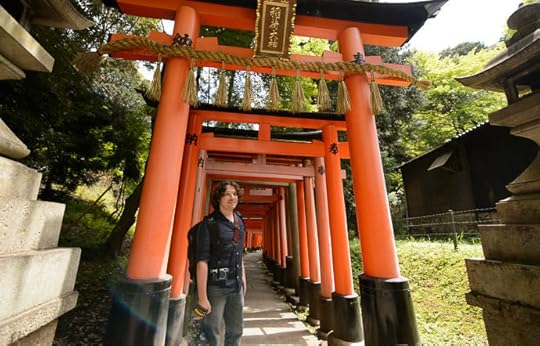
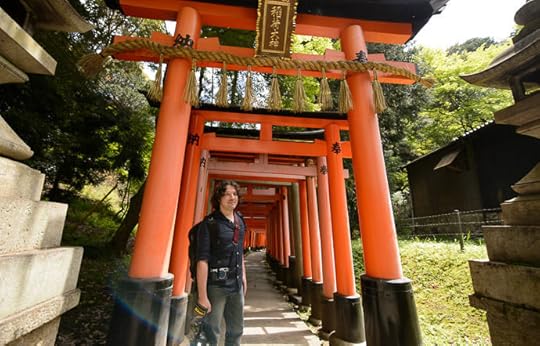
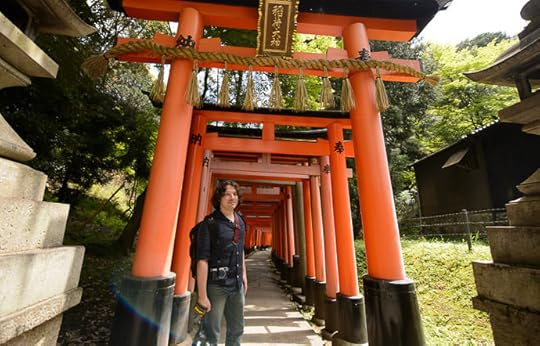
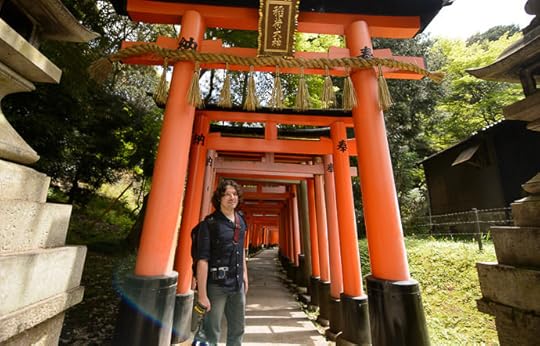
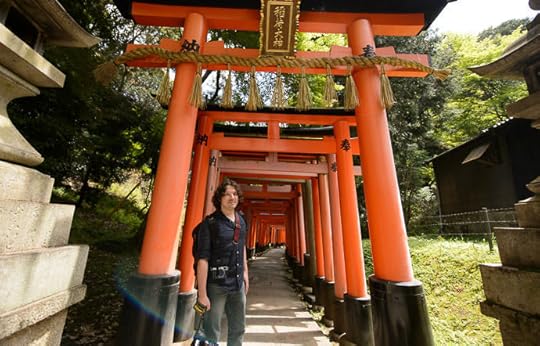
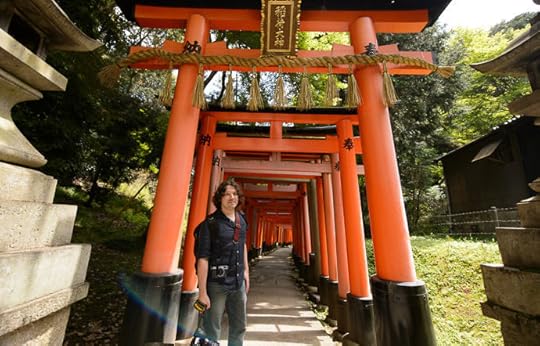
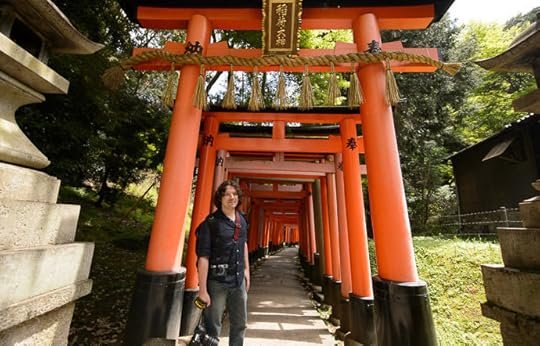
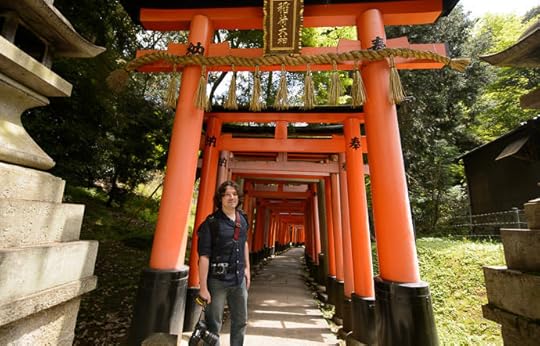
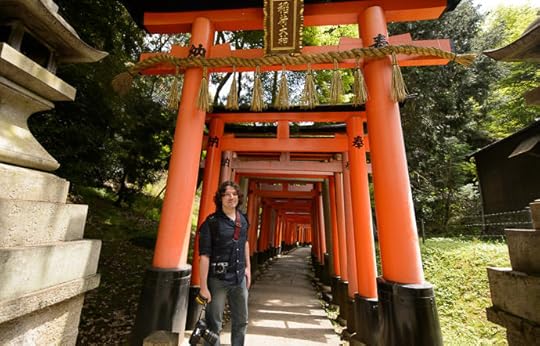
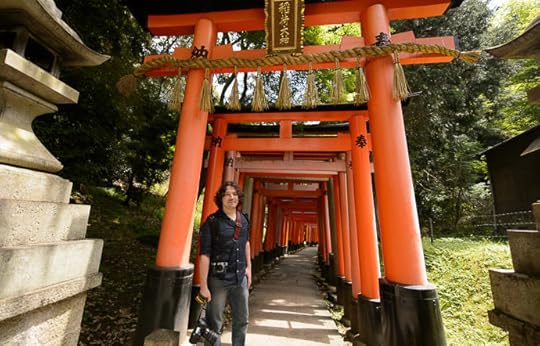
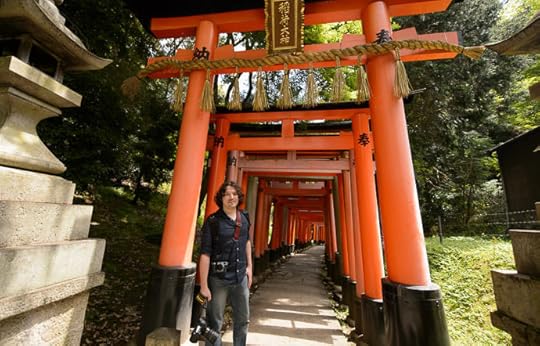
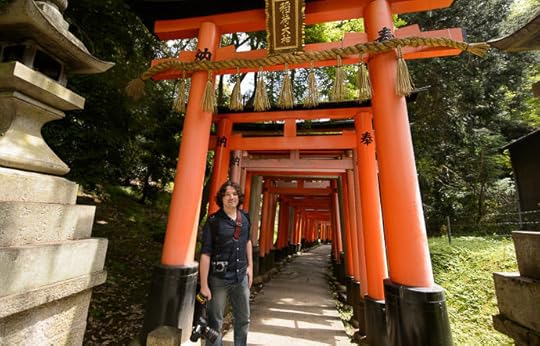
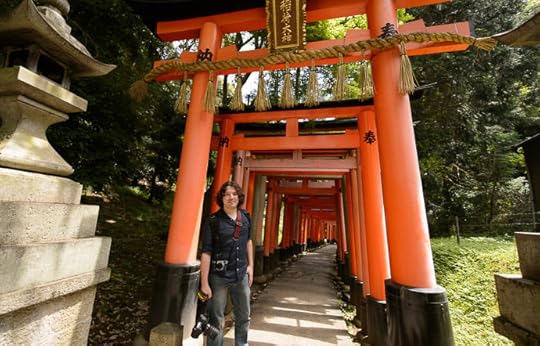
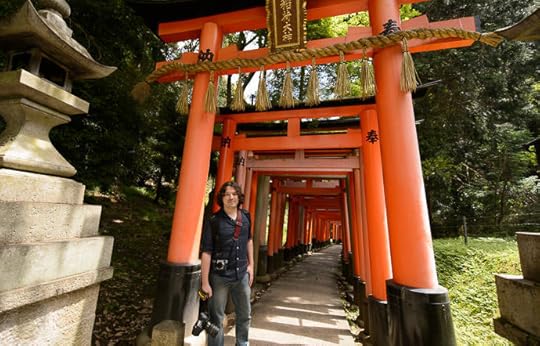
Animatable — slowly sweep mouse from side to side to view effect
写真の上をマウスで左右にゆっくり動かすといろいろな撮影効果を楽しむことができます。
Laid-Back Matt
Matt Campagna at the Fushimi Inari Shrine
Kyoto Japan
=i.length)return 0;else return which;}else{if(which=i.length)return i.length-1;else return which}};t=function(event){if(m>0&&((new Date().getTime())-m)R&&s0){f(c(s-1));console.log(s+":delta is "+delta);L=0.05;R=0.2;T=tilt;}}};d.ontouchmove=d.onmousemove=function(e){if(e.touches&&e.touches.length>1)return true;var x=Math.floor((e.clientX||e.pageX)/BW);var which=c(x>l?s+(x-l):s-(l-x));l=x;if(which!=s){m=new Date().getTime();f(which);}return false;};window.addEventListener('devicemotion',t,false)}
I got to meet Matt Campagna of The Turning Gate Software
yesterday for coffee, conversation, and a hike over the mountain paths of
the Fushimi Inari
Shrine (伏見稲荷大社). He makes highly-regarded Web Gallery plugins for
Lightroom, so we had plenty to talk about with the release of Lightroom 6
that had happened earlier that day.
I think this is my second wigglegrams
I've published from this location, the first having been this one in December.
Neither are quite as nice the previous wigglegram I published last weekend. 
I've tweaked the code for the wigglegram on this one so that it might be a bit
smoother on mobile devices when tilting to wiggle, but considering how mobile-unfriendly
my site is (something made apparent when talking about it with Matt, an expert in this area),
slightly better tilting code is probably just lipstick on a pig. I'll have to find the time
to learn all this mobile stuff...
April 21, 2015
My Thoughts on Lightroom 6

Adobe has just released Lightroom 6.
There are plenty of places to find out about what's new, such
as this post from Adobe for an overview,
or Victoria Bampton's exhaustive "What's New" writeup.
For my part, in this post, I'll just
talk about a few things I think are worth particular mention.
UPDATE: I guess I should mention right away that modern versions (from within the last couple of months) of
my 45 plugins should work fine on
Lightroom 6. The major upgrade does cause registrations of my plugins to be lost, but that's easy enough to fix
(see here).
p.hdr { margin-top: 50px; font-weight: bold; font-size:120% }
p.hd2 { margin-top: 30px; font-weight: bold; font-size:105% }
You Don't Have to Subscribe
Adobe is really pushing the subscription model these days (“Creative Cloud”), so
most of the marketing copy you'll see today references only “Lightroom CC”. The stand-alone version, without
integration to their cloud/mobile offerings, is still available if you dig, but the “Lightroom 6” branding is not being emphasized.
Personally, I like to own (“License”) my copy of software, so I'm glad
that subscription is not the only choice. But in looking at the increased
value of my Adobe stock since they started the move toward subscriptions, I see the writing on the wall that I may not have the choice forever. But today we still do.
Requirement for an Adobe ID
Adobe now flat-out requires an Adobe account to install Lightroom 6. This will
undoubtedly lead to much bellyaching among a vocal minority for whom it is,
on principle, an evil thing... even though like for the rest of us it is
practically-speaking little worse than a one-time 5-minute roadbump.
My personal theory is that this new requirement is to help combat rampant piracy of Lightroom,
which until now had little to curb it.
A side note: most folks probably don't realize that long ago (circa
Lr3), I made it so that my plugins won't run
on a pirated copy of Lightroom, with folks who got caught having to
validate their new, legal copy to my satisfaction before my plugins would
run on their computer again. I suspect that most folks who got caught this
way simply decided to forego the use of my plugins rather than actually pay
for their own copy of Lightroom, yet still, many many (multiple
thousands) folks did respond by buying a copy of Lightroom. I know this
because I handled each validation by hand, and have set aside time several
days a week for the last few years to deal with them.
As a user of Lightroom I want it to grow and thrive, so anything that thwarts pirates
without too much burden on honest customers is fine with me.
Raw Panorama Merge
This might feel like only a mildly-convenient addition in light of long having had the ability
to merge panoramas in Photoshop or other tools, but you've got to realize that this is merging
the pre-develop raw data, creating a single raw file of the merged composition.
It used to be that you had to develop each component photo to whatever
final look you wanted, then do the merge and live with that one result. But now you merge prior to develop, and can then work with the result like any
other raw file, with all the dynamic latitude and no-loss-of-quality
white-balance adjustments that this implies.
I don't have much experience with Lightroom 6's panorama tool, but this
panorama (from the top of this blog post) was
created with Lightroom, from ten fairly bland shots taken by hand in the rain:

merged from 10 separate, hand-held shots, in about as many seconds
I spent all of a few seconds
to select them and invoke “Photo > Photo Merge > Panorama” and let it do its thing. The results certainly exceed the effort that I put into it. 
GPU Acceleration
This new option in the preferences has Lightroom use the processing
power of your system's graphics chip to boost performance, mostly with
render speed in Develop.
With my high-end Mid-2014 MacBook Pro, I've got mixed feelings about this option. It indeed does speed up responsiveness in Develop, sometimes remarkably, but other times it seems to
add a jitter to the display. I haven't pined down exactly what causes it, but I seem to notice
the problem most when using the dust-correction tool.
Luckily the “Performance” tab in the Preferences dialog is sticky, so if
I want to turn it on or off it's just a tap of Command-comma to bring up
the option, and a click to toggle the checkbox.
Face-Detection and People Support
Some people won't care about face detection, but I find it's useful,
especially after you get enough “critical mass” data. My production Lightroom catalog has 135,000 photos going back to 1986, many of them of
family and friends, so there's value for me to be able to quickly identify
all photos with such-and-such a person in them.
It's quite a lot of work to accurately apply this retroactively to
135,000 photos, so I've made only a small dent so far, but it's still useful.
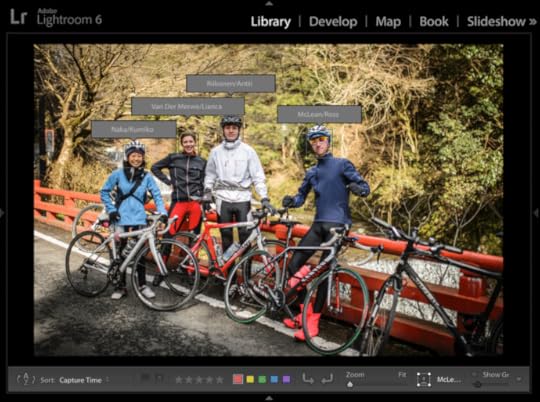
from “Exploring The Mountains of Northern Kyoto by Bicycle”
Of course, one doesn't need automatic face detection to associate people
with photos: many photographers already use keywords to do exactly that. I'm just too lazy to manually go through every photo to assign keywords
that way. Having the hard parts automated tipped the scale for me.
It's not perfect, or even great, but this version seems to be “fairly
good”, with some fairly restrictive design decisions that, how shall I say,
leaves ample room for much improvement in future versions.

Crunching Pixels
There are several steps to the process. The first is that Lightroom's
face-recognition engine must crunch on the pixels in the background to
detect face locations. This can take a long time... on the order of several
days to a week for a catalog like mine.
The first thing I did was turn off the “Automatically detect faces in
all photos” preference item (the “Metadata” tab of Catalog preferences) so
that I can control when Lightroom pegs the CPU looking for faces. In this mode, Lightroom looks for faces only when you've entered the “People” view
(the letter “O” keyboard shortcut) and works on only the selected source.
For the initial check of my 130k photos, I'd select a year or two worth
of photos, enter “People” view, and let it run overnight.
You can assign names to faces (discussed below) while the
pixel-crunching of face detection is going on, but I don't recommend it,
because as new faces are discovered, the Faces-Mode screen keeps updating...
so trying to work with it can be confusing. I've always found it better
to wait until the pixel-crunching face-discovery phase is over for a set of
photos before I start the name-assignment phase.
Person Keywords
In Lightroom, a “Person” is represented by a specially marked keyword,
and most times you'll want to choose the person's name as the text of the
keyword. In Lightroom's “Keywording List”, if you want families to
generally sort together, you'll want to put the family name first. I'd like to put names like “Friedl, Jeffrey”, but a comma
is not allowed in a name, so I can't do that.
In the end I decided to put names like “Friedl/Jeffrey”. It's a bit ugly, but it seems to work
well enough for me. Also, my People Support plugin
has ways to automatically turn
“Friedl/Jeffrey”
into
“Jeffrey Friedl”
on export.
But some folks may well want to choose “FRIEDL
Jeffrey” or “Jeffrey Friedl”. I suggest reading about a variety of approaches before investing a lot of time on
entering names.
Lightroom can let you pick a keyword to be the default parent of all new
People keywords. As you can see at right, I made a keyword named “-PEOPLE-” to hold all my People keywords (that's what
the asterisk next to it means, that it's the default parent). I include the
leading dash in the name so that it sorts to the top of the keyword list;
the trailing dash is just for symmetry.
Warning: newly-created “People” keywords are, by default, marked for inclusion in exported copies of an image. If you prefer to keep them private, you can exclude all “People” keywords via a new option in the Export/Publish
dialogs.
Also, my People Support plugin
allows you to easily see which People keywords are marked for export, and to toggle that state quickly.
Assigning Names to Faces
After faces are found within photos, the next step is to assign names to those faces.
There are a lot of ways to do this (accepting a guess offered by Lightroom,
typing in a new name, dragging thumbnails to named faces, etc.). I'm sure many other
online resources will go over this step better than I could.
Cleaning Up
The automatic face-detection engine misses a lot of faces.... it simply fails to notice their existence.
So, if I really want to make sure that I have fully processed a set of photos, I'll go through them
one by one in Loupe view, with the “Draw Face Regions” option turned on (via clicking the person icon in the toolbar).
In this mode, face rectangles that have been detected are shown, and if you see faces that have not been detected,
you can drag out boxes for them. You can enter the name of each face as you identify it, though it's often easier to leave
them unnamed until you've gone through all the photos, then return to whatever “Assigning Names to Faces” workflow you
find most productive.
You can draw a face rectangle anywhere... it doesn't have to actually be a face:
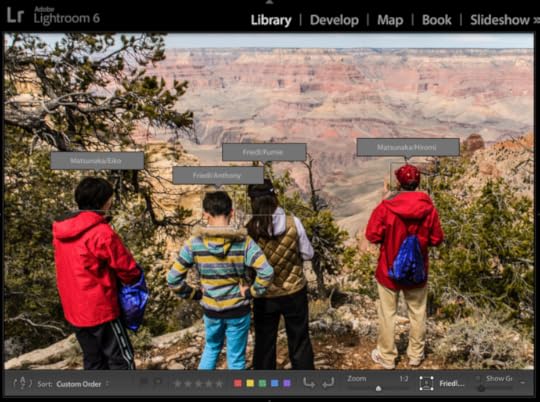
It doesn't even have to be a person... you can use it to mark any object you like.
Lightroom doesn't “learn” from the faces that you draw, so there's no
harm to the “face knowledge base” if the region you identify is not clearly
a face.
Plugin Support for Faces
My People Support plugin has support for “People” keywords,
and some enhanced functionality is enabled when used on Lightroom 6.
My Data Explorer plugin has extra search items when used in Lightroom 6,
for counting people tagged in photos in various ways.
I wish I could have made my Picasa Face-Recognition Import plugin
migrate its data directly to Lr6's people support, but there's no easy way, sorry.
April 19, 2015
Highly-Visible Cycle Ride Though the Mountains of Northern Kyoto
Nikon D4 + Sigma 35mm F1.4 DG HSM — 1/2500 sec, f/2.2, ISO 100 —
map & image data — nearby photos
Sure, A Bit Vibrant
but safety first
photo by Manseki Kanemitsu
Nikon D4 + Sigma 35mm F1.4 DG HSM — 1/3200 sec, f/2.2, ISO 100 —
map & image data — nearby photos
YIKES MY EYES... MAKE IT STOP!
maybe safety is not that important!
For my first “real” cycling ride after my USA vacation, I had a
lot of Under Armour clothes to
choose from. I've been enamored with the
brand for a while, so took the opportunity while in The States of
actually being able to find my size to buy about a thousand dollars worth
of the stuff, from sportswear to casual wear to jackets.
With sportsware I'm partial to loud vibrant colors, especially for
visibility when road cycling. But perhaps in retrospect I shouldn't have
quite gone so full throttle. Still, with this getup I bet I could always
get a job as a rodeo clown.
By the way, the man I'm talking to above is Chris Rowthorn, who just happened
to be walking by when I was meeting others for the start of the ride. He's the author of the Lonely Planet Japan
guidebook, among many others. He used a few of my
photos in his latest edition.
Anyway, I was joined for the ride by
Manseki Kanemitsu, whom I met last month
for this ride,
and Kumiko Naka, whom I met on my first short cycling outing in January.
We decided to ride off to see “the 100-year-old cherry tree”, a well-known tree off in the northern mountains. I mentioned it on my blog in 2007, here.
Nikon D4 + Sigma 35mm F1.4 DG HSM — 1/800 sec, f/9, ISO 640 —
map & image data — nearby photos
Leaving the City
taken while riding at 20 kph
Nikon D4 + Sigma 35mm F1.4 DG HSM — 1/800 sec, f/9, ISO 1100 —
map & image data — nearby photos
Holding Traffic for Us
The road from Kyoto city proper to Kibune and Kurama is often too narrow
to allow a bus and a car to pass each other, so in order to allow bus
service several times a day, traffic is stopped until the bus passes
through. Except during those brief moments of utility, the guy has to sit
in the little hut seen at right in the photo above, being bored. Every time
I pass them I think it must be the world's most boring job. (I've never
seen them reading or the like.) This was the first time I'd actually seen
them performing their task.
We were taking an exceedingly-lazy pace, so didn't mind stopping in front of the
Kurama-dera Temple (鞍馬寺) for photos....
Nikon D4 + Sigma 35mm F1.4 DG HSM — 1/8000 sec, f/1.4, ISO 100 —
map & image data — nearby photos
Manseki
Nikon D4 + Sigma 35mm F1.4 DG HSM — 1/6400 sec, f/1.4, ISO 100 —
map & image data — nearby photos
Me
photo by Manseki
Nikon D4 + Sigma 35mm F1.4 DG HSM — 1/5000 sec, f/1.4, ISO 100 —
map & image data — nearby photos
Kumiko
The road then dives into the mountain almost 800m (2,500 feet) up towards Hanase Pass (花背峠). This would be my second attempt,
the first having been in February chronicled in
“Attempting a 100km Bikeride in the Mountains of Kyoto, Part 1: Hanase Pass”.
This time I wasn't alone, so was happy to have a photo of me while riding...
DMC-SZ9 at an effective 26mm — 1/320 sec, f/3.1, ISO 100 —
map & image data — nearby photos
Plodding Up
photo by Manseki Kanemitsu
I've got my camera slung to my back, and my bike is sporting a new rear
bag that holds 2L of sports drink (that I ended up not using), a light windbreaker, my phone and GPS
unit, among other little things. The design of the cheap rear bag is pretty bad,
though, in how it attaches — just two Velcro straps that can let the
bag roll sideways — so I'll have to see what I can rig up to hold it
more firmly. But everything adds weight, which I already have more than
enough of. 
It's a gut-wrenching never-ending steep road, but I felt better than last time.
I didn't need to drop into the easiest gear until 10 minutes in, rather than right away.
DMC-SZ9 at an effective 26mm — 1/400 sec, f/3.1, ISO 100 —
map & image data — nearby photos
Having My Priorities Straight
photo by Manseki Kanemitsu
Nikon D4 + Sigma 35mm F1.4 DG HSM — 1/800 sec, f/7.1, ISO 1800 —
map & image data — nearby photos
Manseki Photographing Me
taken while riding at 15 kph
I stuck with Manseki (or he held back for me) until I got to the place I stopped
for a rest the first time, and because I have no willpower, I stopped for a rest this time as well. But to my surprise, I didn't stop again until the top.
Nikon D4 + Sigma 35mm F1.4 DG HSM — 1/320 sec, f/8, ISO 6400 —
map & image data — nearby photos
No Snow
unlike last time, where a photo of here was captioned Slushy Road
The main part of the climb, from the Kurama Onsen until the pass, has
a 492m (1,600 ft) elevation gain over less than
6km of road. The first time it took me 47:44, and
this time 43:02. I thought I'd done better than
3½ minutes faster, so I was a bit disappointed. (The best time
registered on Strava for the segment is less than half my time, a blistering 20:26 by Ryo
Inoue last year.)
Kumiko's leg was giving her trouble, so we decided to abandon the long
hilly ride to the cherry tree, and instead return down the mountain a bit and then cut over to the village of Ohara via
Route 477. This would entail a short but
ridiculously-steep section of road that with Kumiko's iffy leg we ended up
walking.
Nikon D4 + Sigma 35mm F1.4 DG HSM — 1/800 sec, f/10, ISO 5000 —
map & image data — nearby photos
Branching Off To Rt477
DMC-SZ9 at an effective 26mm — 1/250 sec, f/3.1, ISO 640 —
map & image data — nearby photos
Takin' it Easy
photo by Manseki Kanemitsu
The tiny village of Momoi has no services that I noticed, except a phone.
Nikon D4 + Sigma 35mm F1.4 DG HSM — 1/800 sec, f/10, ISO 4500 —
map & image data — nearby photos
Old Phone/Telegraph Booth
Nikon D4 + Sigma 35mm F1.4 DG HSM — 1/800 sec, f/10, ISO 1000 —
map & image data — nearby photos
Helping Another Passerby
with directions to Ohara, where we were going ourselves
Nikon D4 + Sigma 35mm F1.4 DG HSM — 1/2500 sec, f/1.6, ISO 100 —
map & image data — nearby photos
Not Yet Purple
but it will be next month; I remember this field from May 2007
Nikon D4 + Sigma 35mm F1.4 DG HSM — 1/800 sec, f/1.6, ISO 560 —
map & image data — nearby photos
Heading Down
much easier than going up
Nikon D4 + Sigma 35mm F1.4 DG HSM — 1/800 sec, f/2.8, ISO 160 —
map & image data — nearby photos
Long Sweeping Road
even though I was holding back because I wasn't familiar with the road, I got up to 56kph (35mph)
Nikon D4 + Sigma 35mm F1.4 DG HSM — 1/1600 sec, f/2.8, ISO 100 —
map & image data — nearby photos
I Remember This Field Too
from when it was being planted in May 2007
taken while riding at 27 kph
Nikon D4 + Sigma 35mm F1.4 DG HSM — 1/2500 sec, f/1.4, ISO 100 —
map & image data — nearby photos
Nearing Ohara
taken while riding at 20 kph
Nikon D4 + Sigma 35mm F1.4 DG HSM — 1/2000 sec, f/2.5, ISO 100 —
map & image data — nearby photos
Missed Opportunity
taken while riding at 27 kph
The out-of-focus farmer is holding a tray of rice seedlings, moving them
from his truck to his greenhouse. I thought a nice photo of this scene
would make a good introduction to the rice-planting season that starts in a
couple of weeks. But when shooting one-handed with little reaction time, I
couldn't get the shot. Oh well.
We stopped by the front garden of a tucked-away temple. (To visit the temple would require an hour's hike, I was told,
so we opted against that.)...
Nikon D4 + Sigma 35mm F1.4 DG HSM — 1/800 sec, f/2.2, ISO 110 —
map & image data — nearby photos
entrance to the Amida Temple (阿弥陀寺)
Nikon D4 + Sigma 35mm F1.4 DG HSM — 1/800 sec, f/3.5, ISO 125 —
map & image data — nearby photos
Manseki
We then arrived in the village of Ohara, and stopped by a restaurant that Manseki knew,
Ohara Riverside Cafe KIRIN...
Nikon D4 + Sigma 35mm F1.4 DG HSM — 1/800 sec, f/4.5, ISO 720 —
map & image data — nearby photos
Stop for Lunch
Riverside Cafe KIRIN
Nikon D4 + Sigma 35mm F1.4 DG HSM — 1/250 sec, f/16, ISO 6400 —
map & image data — nearby photos
Lunch Plate
includes the plate, plus rice, soup, and a huge salad
— It was very good —
Nikon D4 + Sigma 35mm F1.4 DG HSM — 1/800 sec, f/4.5, ISO 125 —
map & image data — nearby photos
Riding Through Ohara
a village in the mountains of Northern Kyoto
taken while riding at 24 kph
We swung around and up to behind the Sanzen'in Temple...
Nikon D4 + Sigma 35mm F1.4 DG HSM — 1/800 sec, f/7.1, ISO 2000 —
map & image data — nearby photos
Passing By
an unused gate of the Sanzen'in Temple
三千院の裏門
I timed the photo to include the gate, knowing that it had been on my blog before.
We continued back into the mountain, past the end of the road...
Nikon D4 + Sigma 35mm F1.4 DG HSM — 1/800 sec, f/2.2, ISO 2000 —
map & image data — nearby photos
Precarious Steps
on slippery rocks in riding shoes with soles that clip onto bike petals
Nikon D4 + Sigma 35mm F1.4 DG HSM — 1/800 sec, f/2.2, ISO 720 —
map & image data — nearby photos
Being Silly
in front of the Otonashi Waterfall (音無の滝)
Nikon D4 + Sigma 35mm F1.4 DG HSM — 1/800 sec, f/3.2, ISO 1000 —
map & image data — nearby photos
Peter Pan Flys
so fast he's out of focus
DMC-SZ9 at an effective 26mm — 1/60 sec, f/3.1, ISO 200 —
map & image data — nearby photos
Shooting Peter Pan
photo by Manseki Kanemitsu
Nikon D4 + Sigma 35mm F1.4 DG HSM — 1/800 sec, f/2.2, ISO 250 —
map & image data — nearby photos
Passing By on the Way Home
Raigo-in Temple (来迎院)
Nikon D4 + Sigma 35mm F1.4 DG HSM — 1/800 sec, f/3.5, ISO 160 —
map & image data — nearby photos
Less-Rural Ohara
taken while riding at 25 kph
According to Strava, my ride was about
60km (37 miles) over a lazy seven hours. Strava's numbers for distance (and
hence speed) and moving time are pretty suspect; I've done my own tracklog analysis
and I believe that they simply calculate incorrectly. But until I create my own
web service and make it available for free, perhaps I shouldn't complain.
A “Flowers Among the Flowers” Wigglegram at Kyoto’s Haradanien Garden
Note: this article may not appear properly in news readers.
This article contains interactive aspects that are likely removed by most news readers. Please see this particular article directly on Jeffrey's blog for full functionality.
div#dpHVXFTIjTIjkdA img { width:690px; height:462px; visibility:hidden; position:absolute; top:0; left:0; border: solid 10px #311}
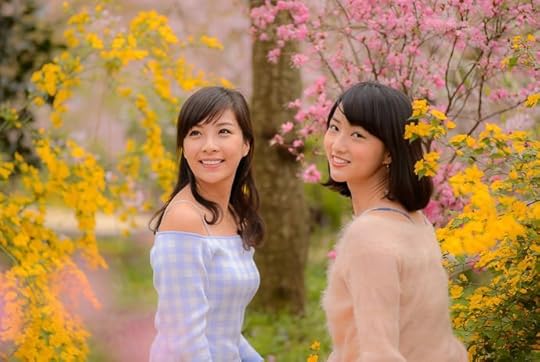
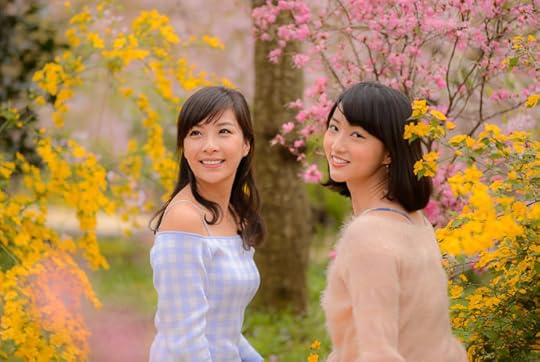
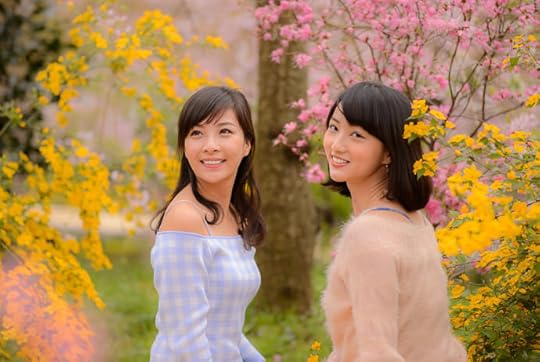
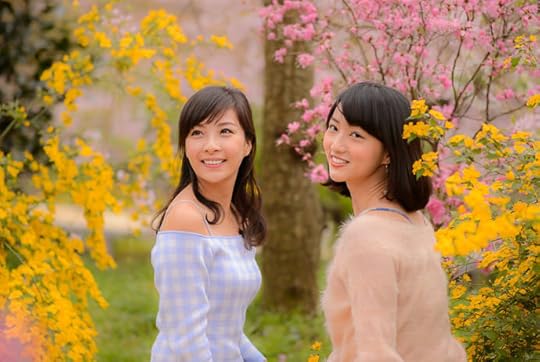
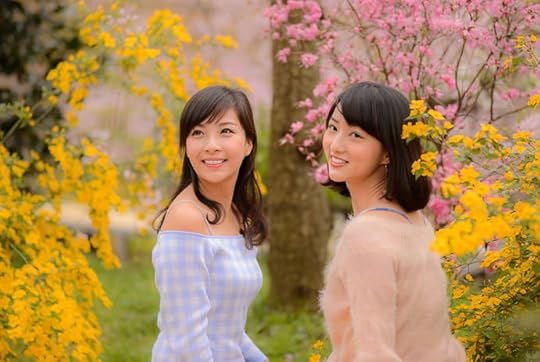
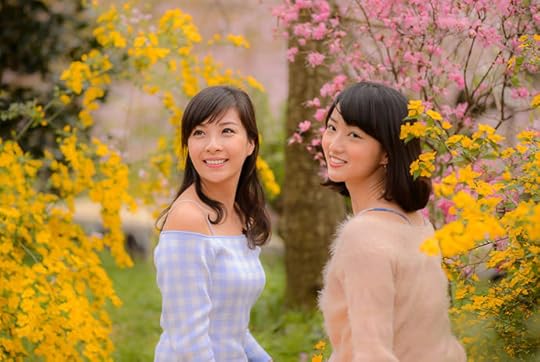
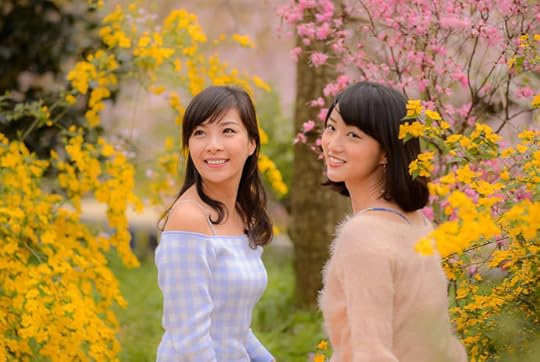
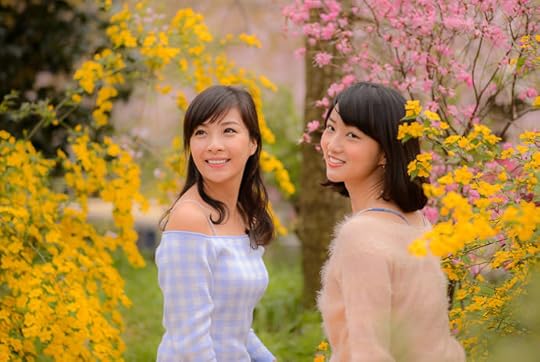
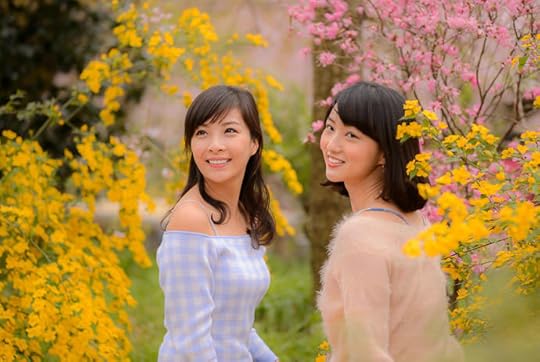
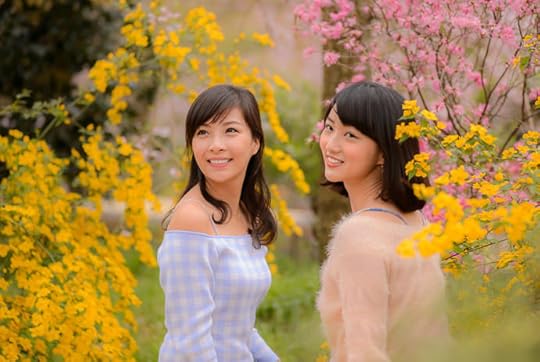
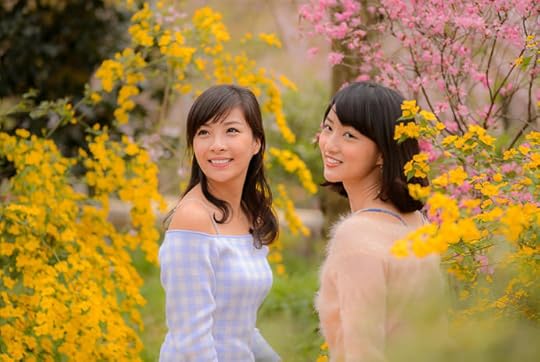
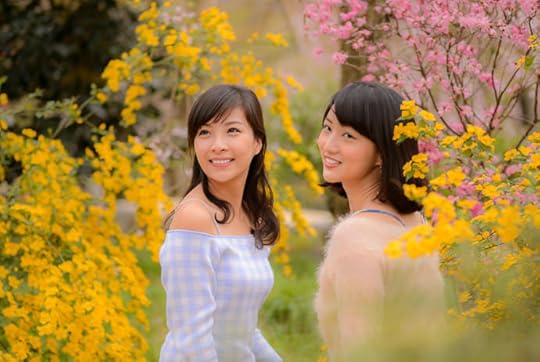
Animatable — slowly sweep mouse from side to side to view effect
写真の上をマウスで左右にゆっくり動かすといろいろな撮影効果を楽しむことができます。
設置動畫 - 慢慢用滑鼠的游標從一邊滑到另一邊查看效果。
0&&((new Date().getTime())-m)=1)f(i.length-1);else f(Math.floor(i.length*per_one));};d.ontouchmove=d.onmousemove=function(e){if(e.touches&&e.touches.length>1)return true;var x=Math.floor((e.clientX||e.pageX)/BW);var which=x>l?s+(x-l):s-(l-x);l=x;if(which>=i.length)which=i.length==2?0:i.length-1;else if(which
Here's a wigglegram
from the same outing that produced “Photoshoot at the
Peak of the Haradanien Garden’s Awesomeness”.
I think it's nicer than my first Haradanien wigglegram, for a variety of reasons.
However, when I showed this to a friend, he said that he felt that the
foliage in the foreground was a bit distracting.
My reaction was “there's foliage?”
Joanne (at left) had to leave Kyoto that day, but Ting Ting (at right)
joined my friends for a photoshoot the next day (which I couldn't
participate in because I was making tofu). But I could join
in the day after that, which lead to
“Photoshoot with Ting Ting at the Murin’an Gardens”.
I've never done much to make my blog design more appealing for handheld
devices like phones and tablets, but I'm taking a small step by trying out
some new wigglegram code. On devices that support it, it should “wiggle” as
you tip the device side to side. For reasons I haven't figured out, it's still much smoother
to swipe from side to side with a finger on a touchscreen, but at lest it's a step.
April 16, 2015
Lunch in a Small Mountain Farming Hamlet in Japan
Note: this article may not appear properly in news readers.
This article contains interactive aspects that are likely removed by most news readers. Please see this particular article directly on Jeffrey's blog for full functionality.



Nikon D4 + Nikkor 24-70mm f/2.8 @ 31mm — 1/500 sec, f/4.5, ISO 1250 —
map & image data — nearby photos
The Lower Quarter
the lower ¼ of the hamlet of Hata (Takashima City, Shiga, Japan)
— scroll side-to-side — 水平にスクロールしてね —
or click through to a 7,900-pixel-wide version
In my previous post, I wrote how I spent a wonderful afternoon making tofu in
japan with an 80-year-old farmer's wife. This post is about the rest of
the visit, the experience that would normally be part of a
tour one can take on a day trip out of Kyoto.
The tofu/meal part of the tour takes place in the hamlet of Hata (畑,
literally “field”) tucked in the mountains of north-western Shiga
prefecture. The terraced rice paddies, tended by hand for generations,
can be quite photogenic, though my visit, two or three weeks before
the planting, found them at perhaps their least photogenic.
Still, I was there, so I took some photos amidst a drizzle. The president of the tour company was my
photography assistant. 
iPhone 6 + iPhone 6 back camera 4.15mm f/2.2 at an effective 70mm — 1/240 sec, f/2.2, ISO 32 —
map & image data — nearby photos
Taking the Panorama Above
photo by Emi Yoshida
Nikon D4 + Voigtländer 125mm f/2.5 — 1/8000 sec, f/2.5, ISO 1250 —
map & image data — nearby photos
Irregular Shape
these terraces have not been modernized for heavy equipment
iPhone 6 + iPhone 6 back camera 4.15mm f/2.2 at an effective 37mm — 1/120 sec, f/2.2, ISO 40 —
map & image data — nearby photos
Another of Me and My Assistant
just because I can

photo by Emi Yoshida
Nikon D4 + Voigtländer 125mm f/2.5 — 1/8000 sec, f/2.5, ISO 1250 —
map & image data — nearby photos
Photo I Was Taking Above
Nikon D4 + Voigtländer 125mm f/2.5 — 1/800 sec, f/5.6, ISO 1250 —
map & image data — nearby photos
Robust Farm House
At the end of the tofu
story I mentioned that the left over “soy pulp” is normally discarded
because it has such a short shelf life, but that we made a dessert with it.
Doughnuts!
Nikon D4 + Nikkor 24-70mm f/2.8 @ 38mm — 1/160 sec, f/2.8, ISO 5000 —
map & image data — nearby photos
Adding a bit of Pancake Mix
perhaps 1 part pancake mix to three parts soy pulp
おから¾、ホットケーキミックス¼、卵一個
Nikon D4 + Nikkor 24-70mm f/2.8 @ 48mm — 1/200 sec, f/2.8, ISO 3600 —
map & image data — nearby photos
Mixing with Digital Technology
after having added an egg
Nikon D4 + Nikkor 24-70mm f/2.8 @ 70mm — 1/320 sec, f/2.8, ISO 2000 —
map & image data — nearby photos
Raw Doughnut Holes
ready for frying
The main dish for lunch was going to be tenpura, an
assortment of light batter-fried veggies. The tour-company staff asked
whether such-and-such a vegetable would be included, and the answer was
essentially "wasn't planning on it, but there's plenty growing outside
anywhere you look... go grab some". So we did.
Nikon D4 + Nikkor 24-70mm f/2.8 @ 35mm — 1/160 sec, f/2.8, ISO 140 —
map & image data — nearby photos
Foraging for Lunch
Nikon D4 + Nikkor 24-70mm f/2.8 @ 24mm — 1/100 sec, f/2.8, ISO 110 —
map & image data — nearby photos
Found Some!
tour-company executive getting her hands dirty
(whatever it was looked like weeds to me, but it turned out quite tasty)
Much farther up the hill than the outside shots I'd taken before, I took the opportunity for more pictures...
Nikon D4 + Nikkor 24-70mm f/2.8 @ 62mm — 1/250 sec, f/9, ISO 1100 —
map & image data — nearby photos
Flooding the Paddies
In preparation for early-May planting, the paddies are slowly being
flooded. It appears that water is diverted from mountain streams to fill
the top paddy in any section; when it overflows, it starts to fill the one
below, and so on.
Nikon D4 + Nikkor 24-70mm f/2.8 @ 24mm — 1/100 sec, f/2.8, ISO 180 —
map & image data — nearby photos
Back of the House
in a spot carved out of the hill
Nikon D4 + Nikkor 24-70mm f/2.8 @ 24mm — 1/100 sec, f/2.8, ISO 250 —
map & image data — nearby photos
in Front of the House
small little garden area
Back inside, the veggies we brought in were washed...
Nikon D4 + Nikkor 24-70mm f/2.8 @ 58mm — 1/250 sec, f/2.8, ISO 5000 —
map & image data — nearby photos
Nikon D4 + Voigtländer 125mm f/2.5 — 1/640 sec, f/2.5, ISO 2500 —
map & image data — nearby photos
Pre-Prepared Veggies
including eggplant, bamboo sprouts, mushrooms, some giant beans, etc.
Nikon D4 + Voigtländer 125mm f/2.5 — 1/500 sec, f/2.5, ISO 6400 —
map & image data — nearby photos
Batter Up!
Nikon D4 + Voigtländer 125mm f/2.5 — 1/400 sec, f/2.5, ISO 6400 —
map & image data — nearby photos
Deep Fry
in a shallow pan
Nikon D4 + Voigtländer 125mm f/2.5 — 1/50 sec, f/4, ISO 6400 —
map & image data — nearby photos
Ingenious
you learn some tricks over 60 years
I loved how she made more space in her tiny kitchen. She put a glass pot lid upside down
over a gas-stove burner... it fit perfectly. On top of that a metal rack, and on top of that
whatever had just come out of the fryer to drip and cool.
Nikon D4 + Nikkor 24-70mm f/2.8 @ 27mm — 1/125 sec, f/2.8, ISO 6400 —
map & image data — nearby photos
Assembly Line
Nikon D4 + Voigtländer 125mm f/2.5 — 1/160 sec, f/2.5, ISO 6400 —
map & image data — nearby photos
Beans and Shrimp
glopped in all at once, the combo fused together in frying
Nikon D4 + Voigtländer 125mm f/2.5 — 1/200 sec, f/2.5, ISO 6400 —
map & image data — nearby photos
Bean and Shrimp Combo
Nikon D4 + Voigtländer 125mm f/2.5 — 1/400 sec, f/2.5, ISO 6400 —
map & image data — nearby photos
Savory Garnish
adding a savory miso-based garnish she made herself, to the tofu she made herself
Nikon D4 + Nikkor 24-70mm f/2.8 @ 38mm — 1/160 sec, f/2.8, ISO 2800 —
map & image data — nearby photos
Meal
prior to rice and soup being added
Nikon D4 + Nikkor 24-70mm f/2.8 @ 24mm — 1/80 sec, f/2.8, ISO 6400 —
map & image data — nearby photos
Receiving Rice
Nikon D4 + Nikkor 24-70mm f/2.8 @ 31mm — 1/100 sec, f/2.8, ISO 6400 —
map & image data — nearby photos
First Taste of Our Tofu
it was delicious, and could stand on its own without garnish
As I mentioned before, I was asked to join on this adventure to take
photos for the tour company, but in the past I'd been on a variety of other tours with
the same company as a “test customer”, to provide feedback on how to make
their tours a better experience for their target audience (English-speaking
tourists looking for something more than the popular tourist spots). For example,
as part of one tour I visited
this gargoyle-tile workshop. I've had some amazing experiences
with them.
Anyway, along the lines of offering feedback, I suggested that the
foreign tourist might want the option to sample some saké with such
a fine meal, and somehow this lead to the lady bringing out some of her
home-made spirits for us to sample.
Nikon D4 + Nikkor 24-70mm f/2.8 @ 36mm — 1/125 sec, f/2.8, ISO 6400 —
map & image data — nearby photos
In High Spirits
Nikon D4 + Nikkor 24-70mm f/2.8 @ 42mm — 1/60 sec, f/2.8, ISO 6400 —
map & image data — nearby photos
Very Home Made
the “label” says that it dates from 2000, 15 years old
These kind of things are fairly simple to make... you fill a jar with
something to provide flavor, say, plums, then top it off with some kind of
spirit... perhaps vodka, shochu, or wine.
Then wait enough years for the flavor to transfer, and voilà, you've
got “plum wine” or the like.
Based on how one goes about doing it, the results can vary wildly. It's always fun to order “plum wine” at a restaurant without knowing the
specific maker because the flavor can range from as sweet as Kool-Aid to as
bitter as orange juice just after brushing your teeth, and the alcoholic
strength can range from “essentially water” to “this will not only grow
hair on your chest, but will simultaneously burn it off”.
Nikon D4 + Nikkor 24-70mm f/2.8 @ 24mm — 1/100 sec, f/2.8, ISO 6400 —
map & image data — nearby photos
Receiving a Glass
Nikon D4 + Nikkor 24-70mm f/2.8 @ 24mm — 1/100 sec, f/2.8, ISO 4500 —
map & image data — nearby photos
Bottom's Up
It turns out that this was at the extreme end of both, and it was too strong/bitter for
me to enjoy. I have photos of the two tour-company ladies giving it a try, with their
face scrunched up in an “oh my gosh this is horrible” anguished cringe. They looked
like shar pei dogs. I will hold these
photos for possible blackmail at a later date. 
As a side note, I've (finally) discovered a way to get better photos
when asking random folks to take a photo of me with my camera. Most folks are
intimidated by a big SLR, and are not used to a viewfinder (they're used to
looking at the back of their phone). In the past I'd set everything
up, pre-set the focus point to some easy-to-notice location in the scene such as my eye, then tell them
to place the little red square on my eye and press the button. Results have
been very mixed, with most photos completely out of focus.
This time I had the bright idea to put my camera in live-view mode (a
mode that I personally don't care for... I can't see the screen that close
without my glasses) and focus in face-recognition mode. Then all they have
to do is point and press, and hopefully it works out. It seems to have in the photo
above.
To say that lunch was filling would be quit the understatement,
so it was with some dread that we realized we'd still not had the
doughnuts.
At least in my case, hot coffee does wonders to settle a full tummy...
Nikon D4 + Nikkor 24-70mm f/2.8 @ 34mm — 1/160 sec, f/2.8, ISO 3600 —
map & image data — nearby photos
Always the Gracious Host
Nikon D4 + Voigtländer 125mm f/2.5 — 1/125 sec, f/5.6, ISO 6400 —
map & image data — nearby photos
Homemade Doughnuts
The doughnuts were slightly sweet, but not overly so, so Americans used to really sweet stuff would
likely want to have these with honey, powered sugar, or perhaps marmalade. Personally, I liked them just
as they were.
Nikon D4 + Nikkor 24-70mm f/2.8 @ 60mm — 1/250 sec, f/2.8, ISO 4500 —
map & image data — nearby photos
Warm Doughnuts, Warm Conversation
All in all it was a wonderful experience, just as all those I've had the
pleasure to enjoy with Tour du Lac Biwa. On this photo-taking visit there was no one to translate (which is fine,
since I can speak Japanese well enough), but on the full tour,
English-speaking staff is there to explain and translate. Highly
recommended.
April 11, 2015
Making Tofu in Japan with an 80-Year-Old Farmer’s Wife
Nikon D4 + Voigtländer 125mm f/2.5 — 1/640 sec, f/2.5, ISO 2500 —
map & image data — nearby photos
Pre-Tofu
soybeans, prior to becoming tofu
I had a fantastic experience on Friday, part of which included making
tofu from scratch with an 80-year-old lady in her old farmhouse in northern
Shiga prefecture, about an hour from Kyoto.
Nikon D4 + Voigtländer 125mm f/2.5 — 1/500 sec, f/2.5, ISO 6400 —
map & image data — nearby photos
Kimiko Sawai
She's five-foot-nothing of pure grandmotherly warmth, but was a bit shy of the camera, so my photos of her don't
really reflect her incessant beaming smile. I was
there as a photographer on behalf of Tour du Lac Biwa, a
tour company that arranges off-the-beaten-path “experience” tours in
Shiga prefecture, for English-speaking visitors. It's
the same tour company that I
appeared on TV for, and that arranged this gargoyle-tile workshop
visit.
Friday's tofu-making experience is part of this
tour about taking life at a slower, countryside pace. Some of my photos
will likely find their way to that page.
I was well paid for my photography work, leaving her house with a belly
beyond full with her simple, close-to-nature farmer's-wife cooking made
with the skill honed during 58 years of marriage and back-breaking by-hand
mountain farming. The ultra-fresh hand-made tofu discussed in this post
ended up being just one little dish of the entire meal, but that's the
subject of a later post.
Nikon D4 + Voigtländer 125mm f/2.5 — 1/640 sec, f/2.5, ISO 5600 —
map & image data — nearby photos
Blending the Soy Beans
I had no idea how tofu was made, but now I'm quite the expert, so let me list the ingredients:
soy beans
water
small sprinkle of concentrated sea water (or other coagulant)
hard work
The beans were apparently soaked in water overnight. As I arrived, she
was pouring off the water into a big pot, then blending the beans as seen
above.
Nikon D4 + Nikkor 24-70mm f/2.8 @ 62mm — 1/125 sec, f/4.5, ISO 6400 —
map & image data — nearby photos
Almost As Ancient as the Cook
her blender, a Panasonic MJ-140K, likely dates from the 70s.
The pureed beans and the water they had been soaking in are then simmered for about half an hour
while being constantly stirred.
Nikon D4 + Nikkor 24-70mm f/2.8 @ 35mm — 1/40 sec, f/10, ISO 6400 —
map & image data — nearby photos
Kitchen Helper
Hiromi-san, the president of the tour company, helps stir
Nikon D4 + Nikkor 24-70mm f/2.8 @ 24mm — 1/100 sec, f/2.8, ISO 5000 —
map & image data — nearby photos
My Turn to Stir
photo by Hiromi-san
This is in the lady's private house that's been in her family for
generations (though she married into it only 58 years ago). What you see is
extremely typical of a “modern” old Japanese-farmhouse kitchen. Nothing's for show here.
Nikon D4 + Nikkor 24-70mm f/2.8 @ 24mm — 1/50 sec, f/4.5, ISO 6400 —
map & image data — nearby photos
Checking the Status
with a well-practiced finger
The lady in the foreground, Emi-san, is also an executive at the tour company
Nikon D4 + Nikkor 24-70mm f/2.8 @ 44mm — 1/160 sec, f/4.5, ISO 6400 —
map & image data — nearby photos
The Tide Can Not Be Held Back
Despite that we were there to impose on her (she was doing us a favor by running through all this for the camera),
her natural kindness as a host could not be curbed, so she insisted we stop helping and have tea. I just wish my photos
would have captured the warmth of her presence... she looks a bit severe in the photo above, but was anything but.
Nikon D4 + Voigtländer 125mm f/2.5 — 1/640 sec, f/2.5, ISO 4000 —
map & image data — nearby photos
Light Snack
Nikon D4 + Nikkor 24-70mm f/2.8 @ 29mm — 1/125 sec, f/2.8, ISO 3600 —
map & image data — nearby photos
Temperature Adjustment
slowly adding cool water to adjust the temperature slightly
Nikon D4 + Nikkor 24-70mm f/2.8 @ 26mm — 1/100 sec, f/2.8, ISO 2800 —
map & image data — nearby photos
Filtering Out the Solids
After it had simmered for about 35 minutes, it was time to filter out the solids. The hot liquid at this point was now soy milk.
Nikon D4 + Nikkor 24-70mm f/2.8 @ 24mm — 1/100 sec, f/2.8, ISO 2800 —
map & image data — nearby photos
Nikon D4 + Nikkor 24-70mm f/2.8 @ 24mm — 1/100 sec, f/2.8, ISO 2200 —
map & image data — nearby photos
Did I mention that it was hot. Hiromi-san was trying to not get burnt, but
Kimiko-san (the old lady) just commented “yup, it's hot, isn't it”. She's done this before. 
Usually she does it all by herself, but this time she had to accommodate “helpers”.
Nikon D4 + Nikkor 24-70mm f/2.8 @ 24mm — 1/100 sec, f/2.8, ISO 6400 —
map & image data — nearby photos
Every Bit Counts
Nikon D4 + Nikkor 24-70mm f/2.8 @ 48mm — 1/200 sec, f/2.8, ISO 6400 —
map & image data — nearby photos
Squeezing Out Remaining Soy Milk
using the same spatula she's used for 58 years
(she's using the spatula instead of her hands because the stuff is really hot)
Nikon D4 + Voigtländer 125mm f/2.5 — 1/160 sec, f/2.5, ISO 6400 —
map & image data — nearby photos
Sip of Fresh Soy Milk
I tried soy milk before, from a California supermarket. It was horrible,
tasting like what I imagine water wrung from a tree-hugger's old socks
would taste like.
On the other hand, this warm, fresh soy milk was excellent. This was
perhaps my biggest surprise of the day.
Of course it's not at all related to milk, but “soy milk” sounds better
than “simmered-bean juice”.
Nikon D4 + Voigtländer 125mm f/2.5 — 1/640 sec, f/2.5, ISO 3200 —
map & image data — nearby photos
Precision High-Tech Instrumentation
66°C (150°F)
The only time she used anything other than her finger and experience to
judge the status was when she measured the temperature of the soy milk
prior to adding the coagulant. It had cooled a bit more than she wanted
(too many cooks in the kitchen slows things down, I guess), but deemed it
safe to proceed.
Nikon D4 + Nikkor 24-70mm f/2.8 @ 36mm — 1/160 sec, f/2.8, ISO 5600 —
map & image data — nearby photos
A Splash of Concentrated Sea Water
Nikon D4 + Nikkor 24-70mm f/2.8 @ 27mm — 1/125 sec, f/2.8, ISO 2500 —
map & image data — nearby photos
“Natural Bittern”
I had to look up “bittern”. My dictionary says:
“a concentrated solution of various salts remaining after the crystallization of salt from seawater”
Adding this bit of salt causes the soy milk to coagulate, separating into tofu and water.
Nikon D4 + Voigtländer 125mm f/2.5 — 1/640 sec, f/2.5, ISO 6400 —
map & image data — nearby photos
Coagulation Is Not Photogenic
but it's part of the story
She then gently poured the tofu/water combo onto a filter cloth set in a colander...
Nikon D4 + Nikkor 24-70mm f/2.8 @ 31mm — 1/125 sec, f/2.8, ISO 3200 —
map & image data — nearby photos
Nikon D4 + Nikkor 24-70mm f/2.8 @ 40mm — 1/160 sec, f/2.8, ISO 5000 —
map & image data — nearby photos
Gently Wrapping Wet Tofu
Nikon D4 + Nikkor 24-70mm f/2.8 @ 38mm — 1/160 sec, f/2.8, ISO 5000 —
map & image data — nearby photos
Nikon D4 + Nikkor 24-70mm f/2.8 @ 56mm — 1/200 sec, f/2.8, ISO 6400 —
map & image data — nearby photos
Slowly Draining
The newborn tofu swaddled tenderly in filter cloth, she set a pan on top
and filled it with water. This provides a gentle pressure to slowly, gently
squeeze out more water. She let it sit like that for about 40 minutes while
she worked on other parts of the meal.
Nikon D4 + Nikkor 24-70mm f/2.8 @ 32mm — 1/125 sec, f/2.8, ISO 1250 —
map & image data — nearby photos
Peeking at the Result
Nikon D4 + Nikkor 24-70mm f/2.8 @ 50mm — 1/200 sec, f/5, ISO 3200 —
map & image data — nearby photos
Fresh Tofu
Nikon D4 + Voigtländer 125mm f/2.5 — 1/200 sec, f/5.6, ISO 6400 —
map & image data — nearby photos
Ready to Eat
just add garnish
Unlike soy milk, which I'd tried the one time long ago then never again
until today, I've had tofu many many times. Generally it has no taste, and
is just a healthful delivery vehicle for garnishes or other tastes.
This fresh tofu was different... it had a sublime soft deliciousness that's hard to describe,
but it definitely stood on its own as a tasty part of a meal. I didn't want to spoil it with
a garnish, but then Kimiko-san pulled out some home-made miso garnish... but that's a story for another time.
By the way, after straining out the bits of bean pulp from the soy milk after simmering,
those bits of bean become a sawdusty-looking substance called
okara...
Nikon D4 + Voigtländer 125mm f/2.5 — 1/640 sec, f/2.5, ISO 3600 —
map & image data — nearby photos
“Soy Pulp”
おから
It has a very short shelf life so commercial producers of tofu usually throw it away,
but it's highly nutritious, and not something a farmer is going to waste. (It's also
the answer to my soft not-foam-filling “What am I?” quiz from
the other day.)
We ended up making a dessert with it.
(Note: if you visit Japan and want to take this
tour with the specific intention of making tofu, be sure to mention
that because lacking a specific request, what the lady prepares on any
given day depends on the season, what she has on hand, and perhaps her
whim. So be sure to mention specific requests. Some people specifically
avoid tofu, for example, due to allergy or simple dislike of the
stuff.)
To be continued...
Photoshoot with Ting Ting at the Murin’an Gardens
Nikon D4 + Nikkor 85mm f/1.4 — 1/400 sec, f/1.4, ISO 250 —
map & image data — nearby photos
Quiet Moment
at the Murin'an Garden (無鄰菴), Kyoto Japan
Vertical Desktop-Background Versions
1050×1680 · 1200×1920 · 1600×2560
I spent a few hours today in the Murin'an Garden (無鄰菴) in eastern
Kyoto, doing a photoshoot with Ting Ting, which you might remember from “Photoshoot at the
Peak of the Haradanien Garden’s Awesomeness” two days ago.
Like two days ago, I was with Eric, Gigi, and Damien, but this time Gigi was behind her own camera as well...
Nikon D4 + Nikkor 85mm f/1.4 — 1/200 sec, f/8, ISO 6400 —
map & image data — nearby photos
Typical Scene
Nikon D4 + Nikkor 85mm f/1.4 — 1/400 sec, f/2.8, ISO 2500 —
map & image data — nearby photos
Easy Smile
I really enjoyed the situation with three photographers and one subject. While someone else is directing Ting Ting
to look this way or move that way, I can capture pseudo-candid shots that I'd probably not get otherwise.
For example, early on while being directed by Gigi...
Nikon D4 + Nikkor 85mm f/1.4 — 1/400 sec, f/1.8, ISO 560 —
map & image data — nearby photos
From time to time, Ting Ting would also be the photographer...
Nikon D4 + Nikkor 85mm f/1.4 — 1/400 sec, f/1.4, ISO 800 —
map & image data — nearby photos
Nikon D4 + Nikkor 85mm f/1.4 — 1/400 sec, f/1.4, ISO 900 —
map & image data — nearby photos
Enjoying the Garden
Nikon D4 + Nikkor 85mm f/1.4 — 1/400 sec, f/1.4, ISO 640 —
map & image data — nearby photos
Listening
to one of the photographer's direction
Nikon D4 + Nikkor 85mm f/1.4 — 1/400 sec, f/1.4, ISO 360 —
map & image data — nearby photos
Wrapper
for the sweet that comes with the tea
Nikon D4 + Nikkor 85mm f/1.4 — 1/400 sec, f/2.2, ISO 2800 —
map & image data — nearby photos
Typical Scene
Nikon D4 + Nikkor 85mm f/1.4 — 1/400 sec, f/2.2, ISO 360 —
map & image data — nearby photos
Gorgeous Light
Nikon D4 + Nikkor 85mm f/1.4 — 1/400 sec, f/2.2, ISO 1100 —
map & image data — nearby photos
Nikon D4 + Nikkor 85mm f/1.4 — 1/400 sec, f/1.4, ISO 640 —
map & image data — nearby photos
Slight Rimlight
using the iPhone flashlight to add a bit of hair highlight for Gigi's shot
Nikon D4 + Nikkor 85mm f/1.4 — 1/800 sec, f/1.4, ISO 100 —
map & image data — nearby photos
Following
Damien's direction on posing and movement
Nikon D4 + Nikkor 85mm f/1.4 — 1/400 sec, f/4, ISO 450 —
map & image data — nearby photos
Slight Correction
Nikon D4 + Nikkor 85mm f/1.4 — 1/800 sec, f/1.4, ISO 100 —
map & image data — nearby photos
Not Quite
the hands feel staged, but with a smile like that who cares?
Nikon D4 + Nikkor 85mm f/1.4 — 1/400 sec, f/1.4, ISO 125 —
map & image data — nearby photos
Nikon D4 + Nikkor 85mm f/1.4 — 1/400 sec, f/1.4, ISO 180 —
map & image data — nearby photos
Rich Light
Nikon D4 + Voigtländer 125mm f/2.5 — 1/640 sec, f/2.5, ISO 125 —
map & image data — nearby photos
Gigi After the Shoot
doing an exaggerated pose
Eric and Gigi return to America tomorrow. It was great fun with them while they were here.
Jeffrey E.F. Friedl's Blog
- Jeffrey E.F. Friedl's profile
- 13 followers


